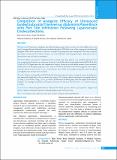Please use this identifier to cite or link to this item:
https://hdl.handle.net/20.500.14356/1490Full metadata record
| DC Field | Value | Language |
|---|---|---|
| dc.contributor.author | Baral, Bidur | - |
| dc.contributor.author | Poudel, Puspa Raj | - |
| dc.date.accessioned | 2023-05-14T09:09:14Z | - |
| dc.date.available | 2023-05-14T09:09:14Z | - |
| dc.date.issued | 2018 | - |
| dc.identifier.citation | BaralB., & PoudelP. R. (2019). Comparison of Analgesic Efficacy of Ultrasound Guided Subcostal Transversus Abdominis Plane Block with Port Site Infiltration Following Laparoscopic Cholecystectomy. Journal of Nepal Health Research Council, 16(41), 457-461. https://doi.org/10.33314/jnhrc.v16i41.1486 | en_US |
| dc.identifier.issn | Print ISSN: 1727-5482; Online ISSN: 1999-6217 | - |
| dc.identifier.uri | http://103.69.126.140:8080/handle/20.500.14356/1490 | - |
| dc.description | Original Article | en_US |
| dc.description.abstract | Abstract Background: Patients have significant pain following laparoscopic cholecystectomy. Several modalities have been used to manage this pain. Subcostal transversus abdominis plane (TAP) block is one of the components of multimodal analgesia and has been described as an effective technique for postoperative pain management. This study compares the impact of subcostal TAP block with port site local infiltration following laparoscopic cholecystectomy for postoperative pain and opioid consumption. Methods: This is a prospective, randomized, interventional study. Sixty patients were enrolled and divided into two groups having 30 patients in each group. Group A received bilateral ultrasound guided subcostal TAP block with 10 mL of 0.25% bupivacaine after the completion of surgery. Group B received similar amount of local anesthetic infiltrated over all the laparoscopic port sites. Pain at rest and on movement was assessed using VAS scale in post-operative period at 0 min, 30 min, 2, 4, 6, 12 and 24 hours. Time of first rescue analgesic requirement and total opioid consumption over 24 hours were recorded. Results: Patients receiving Subcostal TAP block had reduced postoperative pain as compared to port site infiltration and statistically significantly in first two hours after surgery. The 24 hours opioids consumption was significantly less (125mg ±25.42 versus 175mg ±25.42, p <0.001) in Subcostal TAP block group. Time for request of first rescue analgesic was prolonged in patients receiving the Subcostal TAP block (3.20±0.84 hours vs 1.70±0.65 hours, p <0.001). Conclusions: Ultrasound guided bilateral Subcostal TAP block provides effective post-operative analgesia and reduces opioid consumption in patients undergoing laparoscopic cholecystectomy. Keywords: Laparoscopic cholecystectomy; post-operative analgesia; subcostal TAP block. | en_US |
| dc.language.iso | en | en_US |
| dc.publisher | Nepal Health Research Council | en_US |
| dc.relation.ispartofseries | Oct-Dec 2018;1486 | - |
| dc.subject | Laparoscopic cholecystectomy | en_US |
| dc.subject | Post-operative analgesia | en_US |
| dc.subject | Subcostal TAP block | en_US |
| dc.title | Comparison of Analgesic Efficacy of Ultrasound Guided Subcostal Transversus Abdominis Plane Block with Port Site Infiltration Following Laparoscopic Cholecystectomy | en_US |
| dc.type | Journal Article | en_US |
| local.journal.category | Original Article | - |
| Appears in Collections: | Vol. 16 No. 4 Issue 41 Oct - Dec 2018 | |
Files in This Item:
| File | Description | Size | Format | |
|---|---|---|---|---|
| 1486-Manuscript-7886-5-10-20190221.pdf | Fulltext Article. | 202.53 kB | Adobe PDF |  View/Open |
Items in DSpace are protected by copyright, with all rights reserved, unless otherwise indicated.
